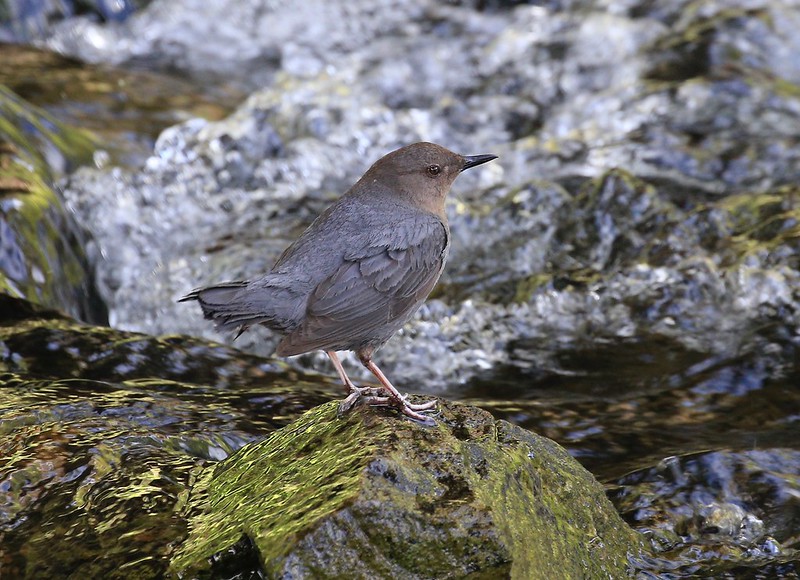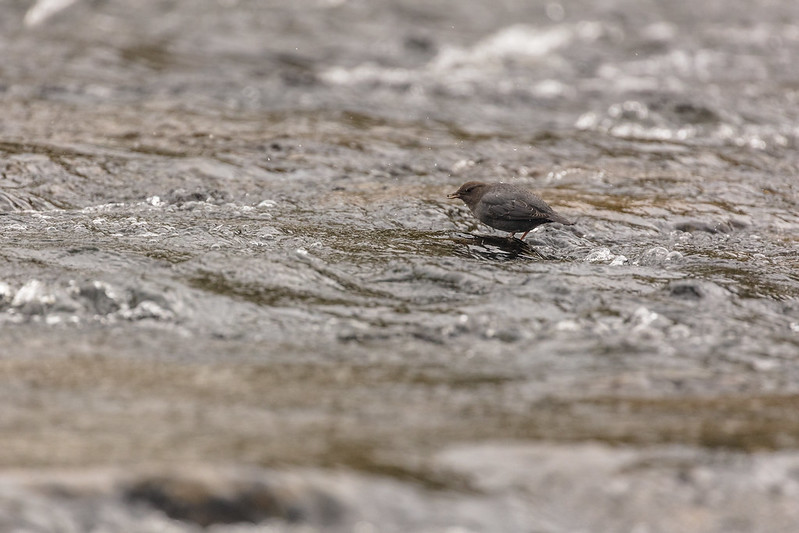
The American Dipper, North America’s only aquatic songbird. Photo credit: “American Dipper – Lou Ann Harris” by Sacajawea Audubon Society is marked with Public Domain Mark 1.0.
My husband and I practice a daily breathing technique developed by Wim Hof, followed by cold exposure training, which for us is usually a 2-7 min or more dip in a cold river or a swim in a cold lake (though a cold shower works too when we must). We’ve been doing this for about 7 years and in the Western US, when doing our dips in fast moving river water, we’ve often been joined by an cold-water loving avian friend – the American Dipper!
The American Dipper, Cinclus mexicanus, formerly known as the Water Ouzel, is a small, chunky bird, rather non-descript in color – grayish brown, with dark eyes and beak, and no distinct markings on its feathers. It blends in well when down on the dark wet rocks and you may not even notice it at first, until a funny movement catches your eye – dip, dip, dip, the bird is doing a little bob-like dance with its tail cocked up in the air, while standing on the rocks. Then, hop! It dips down into the swirling water, head and all, to grab a tasty morsel before jumping out and back onto the rock where the little dance begins again. It’s a funny and curious sight to see, to watch them flit and dance and dive along a stream or river.
The American Dipper is North America’s only aquatic songbird, meaning it spends its life on and near the water, relying on the water itself for its food and nesting area. Common for waterfowl, but not usual for songbirds! The Dipper prefers fast-flowing mountain streams and cold coastal streams, and is found in Alaska, down through the western US, and into Mexico and Central America. Best habitat are streams and rivers with boulders and woody debris that can be used as perches along the stream and out in the middle of the water, with cobblestones or gravel in the streambeds to provide habitat for their prey: aquatic insects, along with fish eggs, insect larva, and even small fish. When foraging, the Dipper will jump into the water and swim or “fly” with its wings, down to the bottom where it will walk along with its wings outstretched and flapping against the current, grabbing up prey off the rocks, staying submerged for up to 15 seconds at a time. To see this in action, click the YouTube link at the end of the blog.

Range map of the American Dipper. Photo credit: https://abcbirds.org/bird/american-dipper/
This April, during one of our first days of going down to the Salmon River to do our cold dip we had the pleasure of watching an American Dipper along the shore, jumping in and out of the water, doing its bobbing on the rocks. Then it flew over to the rocky cliffs just above the water on the opposite shore and…disappeared. It took a few minutes for us to realize what had happened. There on the side of the rocks, over the rushing water, was a dome-shaped pile of what looked like dried grasses with a hole in it – a nest! The bird, male or female I don’t know as they look the same, had flown into the nest where it was either continuing to refine the nest or already incubating eggs. Their nests are actually typically made of mosses, along with grass and leaves in the egg laying center, with the opening facing the water. They commonly nest on these kinds of nearly vertical surfaces, and on ledges, fallen logs, or under bridges and culverts. The female will choose the nesting site, but both sexes will build the nest and rear the young. They have a lovely jumping medley of notes for their song, and both males and females sing beginning in late winter and loudly to be heard over the rushing water! To hear their song, click the All About Birds link at the end of the blog.

Zoomed in photo of a dome nest of mosses and grasses made by an American Dipper above the Salmon River. Photo credit: SIHA staff
But what about the bobbing behavior? And how can these small birds withstand the cold water?
Scientists don’t know for sure why the American Dipper constantly bobs up and down and dips its tail while standing on rocks and land. According to allaboutbirds.org, “Some scientists think that this conspicuous movement helps the birds communicate despite the high background noise in the species’ turbulent environment.”
As to withstanding cold water, they have some neat adaptations just for that. Like other aquatic birds, they have more downy feathers to help insulate and oil glands they use to distribute oil through their feathers to help repel water. A third eyelid, known as a nictitating membrane, which many aquatic creatures have, can be closed to protect the eye and allows them to see underwater. They have scales to plug their nostrils while underwater, can store more oxygen in their bloodstream for diving, and have a lower than usual metabolic rate to help it maintain its internal body temperature even when cold outside or in cold water. I wish I had all those adaptations to cold water!
While American Dipper numbers are estimated to be stable and they are listed as a species of low conservation concern, they can be affected by pollutants in water, such as chemicals, or sediment and heavy metals from logging and mining, as well as habitat loss through the damming of rivers.
To view the American Dipper yourself, find a nice flowing river in the mountains, like the Salmon River right there in the Sawtooths, and go hang out streamside for a while. There’s a good chance you’ll see or hear one, and you might even be inspired to take a cold dip yourself one day!

American Dipper with food in its beak. Photo credit: “American Dipper with food in its beak” by YellowstoneNPS is marked with Public Domain Mark 1.0.
Resources:
Video of American Dipper swimming underwater: https://www.youtube.com/watch?v=ymjPMERnX5A
Song recording: https://www.allaboutbirds.org/guide/American_Dipper/sounds
Sources:
https://abcbirds.org/bird/american-dipper/
https://www.allaboutbirds.org/guide/American_Dipper/overview
Alicia is a naturalist and the 2024 Program Coordinator for SIHA. When not at the Redfish Visitor Center, you’ll find her hiking, making art, taking pictures, and swimming in cold water lakes and rivers with her husband, Jeff.